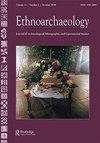Edwin Wilmsen’s Contributions to Ethnoarchaeology
IF 1.3
0 ARCHAEOLOGY
引用次数: 1
Abstract
Although Ed Wilmsen has made crucial contributions to ethoarchaeology, he does not identify himself as an ethnoarchaeologist, and so his important work in this field is often overlooked. He is not mentioned, for example, in the monumental history of ethnoarchaeology by David and Kramer (2000). When I recorded an on-camera interview with him in 2015, he described himself as a four-field anthropologist. The traditional “four fields” of Anthropology in the USA and Canada are Cultural (or Social) Anthropology, Archaeology, Biological Anthropology and Linguistic Anthropology. In the mid1960s Ed Wilmsen and his fellow PhD students in the University of Arizona’s Anthropology Department were required to take rigorous qualifying examinations in all four of these fields. His work on hunter-gatherers in the Kalahari made good use of all of this training and ranged far beyond it into colonial archives, and into the translation and editing of the journals of nineteenth-century European travelers through the Kalahari. As he notes in this essay, when he traveled in 1973 to CaeCae (/Khae/Khae in other publications) for a six-month field season, he shared the then-widespread view that Kalahari hunter-gatherers were among the last living representatives of that evolutionary stage, and that ethnoarchaeological studies of them might be used to infer behavior and social structures of prehistoric hunter-gatherers far distant in time and space from the Kalahari. He anticipated that this would be his only trip to Africa and that he would thereafter be applying the insights gathered from this field season to interpretation of Paleoindian archaeology back in the USA. He never did return to Paleoindian archaeology and has spent the last forty-five years working in Botswana. Between 1973 and 1980 he spent more than three years in the field with Zhu foragers, employing all aspects of his training in four-field anthropology. He learned their language, he studied their subsistence strategies and kinship system, nutrition and fertility, he drew blood for nutritional, endocrine and mt-DNA studies, and he undertook archaeological excavations at CaeCae (Wilmsen 1978). Some of the leading linguists studying Khoisan languages are German, and Ed’s fluency in that language enabled him to delve more deeply into Khoisan historical linguistics than most other anthropologists working with Kalahari hunter-gatherers. All of these lines of inquiry were also being pursued by various members of Lee and DeVore’s research group, but Wilmsen was able to spend more time in the field during the 1970s than any one of them, thanks to three large grants from the US National Science Foundation. He was also commissioned by the government of Botswana, which had become an independent nation only in 1966, to write a lengthy summary of the current status of foraging peoples within its borders.埃德温·威尔森对民族考古学的贡献
虽然Ed Wilmsen对民族考古学做出了重要贡献,但他并不认为自己是一个民族考古学家,因此他在这个领域的重要工作经常被忽视。例如,在大卫和克莱默(David and Kramer, 2000)撰写的不朽的民族考古学历史中,他就没有被提及。当我在2015年录制对他的镜头采访时,他称自己是一个四领域的人类学家。美国和加拿大传统的人类学“四大领域”是文化(或社会)人类学、考古学、生物人类学和语言人类学。在20世纪60年代中期,Ed Wilmsen和他在亚利桑那大学人类学系的博士生们被要求在这四个领域都参加严格的资格考试。他对喀拉哈里沙漠狩猎采集者的研究很好地利用了所有这些训练,并且远远超出了殖民档案的范围,还翻译和编辑了19世纪穿越喀拉哈里沙漠的欧洲旅行者的日志。正如他在这篇文章中所指出的,当他在1973年前往CaeCae (/Khae/Khae在其他出版物中)进行为期六个月的实地考察时,他同意了当时普遍的观点,即喀拉哈里狩猎采集者是该进化阶段最后活着的代表之一,对他们的民族考古学研究可能被用来推断史前狩猎采集者的行为和社会结构,这些狩猎采集者在时间和空间上都与喀拉哈里遥远。他预计这将是他唯一一次非洲之行,此后他将把从这个实地季节收集到的见解应用到美国的古印第安考古解释中。他再也没有回到古印第安考古领域,在博茨瓦纳工作了45年。1973年至1980年间,他花了三年多的时间在朱族采集者的田野里,运用了他在四个领域的人类学训练的各个方面。他学习了他们的语言,研究了他们的生存策略和亲属制度、营养和生育能力,他为营养、内分泌和mt-DNA研究抽血,并在CaeCae进行了考古发掘(Wilmsen 1978)。研究科伊桑语言的一些主要语言学家是德国人,而埃德流利的德语使他能够比其他大多数研究喀拉哈里沙漠狩猎采集者的人类学家更深入地研究科伊桑历史语言学。所有这些研究方向也被李和德沃尔研究小组的不同成员所追求,但在20世纪70年代,威尔姆森比他们中的任何一个人都花了更多的时间在这个领域,这要归功于美国国家科学基金会的三笔大笔资助。1966年刚刚成为独立国家的博茨瓦纳政府还委托他撰写一篇关于其境内觅食民族现状的长篇摘要。
本文章由计算机程序翻译,如有差异,请以英文原文为准。
求助全文
约1分钟内获得全文
求助全文
来源期刊

Ethnoarchaeology
ARCHAEOLOGY-
CiteScore
1.60
自引率
0.00%
发文量
10
期刊介绍:
Ethnoarchaeology, a cross-cultural peer-reviewed journal, focuses on the present position, impact of, and future prospects of ethnoarchaeological and experimental studies approaches to anthropological research. The primary goal of this journal is to provide practitioners with an intellectual platform to showcase and appraise current research and theoretical and methodological directions for the 21st century. Although there has been an exponential increase in ethnoarchaeological and experimental research in the past thirty years, there is little that unifies or defines our subdiscipline. Ethnoarchaeology addresses this need, exploring what distinguishes ethnoarchaeological and experimental approaches, what methods connect practitioners, and what unique suite of research attributes we contribute to the better understanding of the human condition. In addition to research articles, the journal publishes book and other media reviews, periodic theme issues, and position statements by noted scholars.
 求助内容:
求助内容: 应助结果提醒方式:
应助结果提醒方式:


